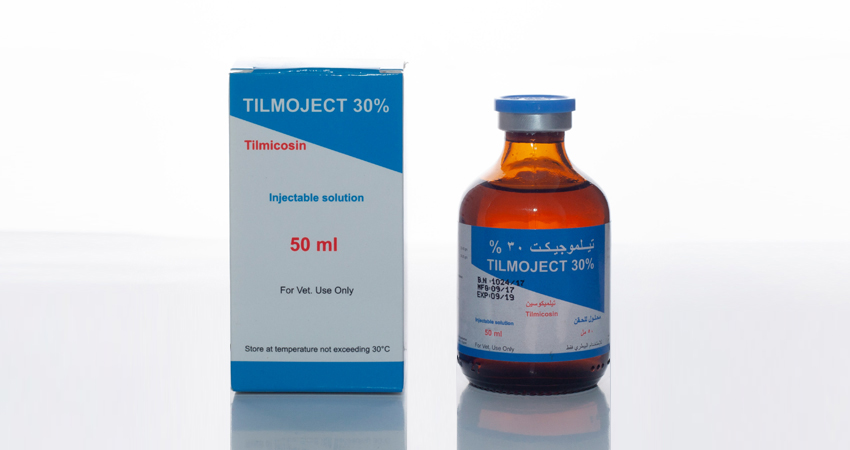Composition
Each 100 ml contains
Tilmicosin phosphate 33.40 gm
Equivalent to Tilmicosin base 30.00 gm
Properties
- Tilmicosin is a semi-synthetic antibiotic of the macrolide group, and is believed to affect bacterial protein synthesis. It is bacteriostatic but at high concentrations, it may be bactericidal. This antibacterial activity is predominantly against Gram-positive microorganisms such as Actinomyces spp. (Corynebacterium) and Staphylococcus spp. with activity against certain Gram-negative ones such as Mannheimia spp., Pasteurella spp. and Fusobacterium spp. and Mycoplasma of bovine and ovine origin.
Indications
Cattle
- Treatment of Bacterial Pneumonia caused by Mannheimia haemolytica, and Pasteurella multocida.
- Treatment of interdigital necrobacillosis (bovine pododermatitis, foul in the foot).
Sheep
- Treatment of Bacterial Pneumonia caused by Mannheimia haemolytica and Pasterurella multocida.
- Treatment of foot rot caused by Dichelobacter nodosus and Fusobacterium necrophorum..
- Treatment of ovine mastitis associated with Staphylococcus aureus and Mycoplasma agalactiae.
Target Species:
Cattle and Sheep.
Dosage &administration:
Route of administration: For subcutaneous injection only
For active Ingredient:
Cattle and Sheep: 10 mg Tilmicosin / kg body weight in a single dose.
For whole product:
Cattle and Sheep: 1 ml Tilmoject 30%/ 30 kg body weight in a single dose.
Warnings
- Do not administer to lambs weighing less than 15 kg, since there is a real risk of overdosage toxicity. Accurate weighing of lambs is important to avoid overdosage. The use of a 2 ml or smaller syringe will facilitate accurate dosing.
- A bacteriological cure of acute ovine mastitis caused by Staphylococcus aureus and Mycoplasma agalactiae has not been demonstrated by a clinical trial.
Precautions:
Precautions for humans:
- Injection of tilmicosin in humans can be fatal.
- Exercise extreme caution to avoid accidental self-injection and follow up the administration instructions and the guidance below, precisely.
- This product should only be administered by a veterinary surgeon.
- Never carry a syringe loaded with the product with the needle attached. The needle should be connected to the syringe only when filling the syringe or administering the injection. Keep the syringe and needle separate at all other times.
- Do not use automatic injection equipment.
- Ensure that animals are properly restrained, including those in the vicinity.
- Do not work alone when using the product.
- In case of self-injection seek immediate medical attention and take the vial or the package leaflet with you. Apply a cold pack (not ice directly) to the injection site.
- Avoid contact with eyes.
- May cause sensitisation by skin contact.
- Wash hands after use.
- The cardiovascular system is the target of toxicity, and this toxicity may be due to calcium-channel blockade. Administration of intravenous calcium chloride should only be considered if there is positive confirmation of exposure to tilmicosin.
- Do not give adrenalin or beta-adrenergic antagonists such as propranolol.
- Pre-clinical data and an isolated clinical report suggest that calcium chloride infusion may help to reverse tilmicosin induced changes in blood pressure and heart rate in humans.
- Administration of dobutamine should also be considered due to its positive inotropic effects although it does not influence tachycardia.
- As tilmicosin persists in tissues for several days, the cardiovascular system should be closely monitored and supportive treatment provided.
Precautions for animals:
- Use of the product should be based on susceptibility testing of the bacteria isolated from the animal. If this is not possible, therapy should be based on local (regional, farm level) epidemiological information about susceptibility of the target bacteria.
Precautions during pregnancy, lactation and laying:
- The safety of the veterinary medicinal product has not been established during pregnancy.
- Use only according to the benefit-risk assessment by the responsible veterinarian.
Contra – Indications
- Do not administer intravenously.
- Do not administer intramuscularly.
- Do not administer to lambs weighing less than 15 kg.
- Do not administer to horses or donkeys.
- Do not administer to goats.
- Do not administer to primates.
- Do not use in cases of known hypersensitivity to the active substance or any of the excipients.
Drug-drug interaction:
Interactions between macrolides and ionophores have been observed in some species.
Adverse Effects
- Occasionally, a soft diffuse swelling may occur at the injection site, but this disappears within five to eight days.
- Deaths of cattle have been observed following a single intravenous dose of 5 mg/kg, and following the subcutaneous injection of doses of 150 mg/kg at 72 hour intervals. Sheep have died following a single intravenous injection of 7.5 mg/kg.
Poisoning:
- The acute manifestations of multiple injections of large subcutaneous doses (150 mg/kg) in cattle included moderate electrocardiographic changes accompanied by mild focal necrosis, marked injection site oedema and death.
- Single subcutaneous administration injection of 30 mg/kg in sheep produced increased respiratory rate, and at higher levels (150 mg/kg) ataxia, lethargy and drooping of the head.
Withdrawal time
Cattle:
- Meat & offal: 70 days.
- Milk: 36 days.
Sheep:
- Meat & offal: 42 days.
- Milk: 18 days
.
Storage conditions
Store at temperature not exceeding 30ºC
Presentation
Injectable solution – amber glass vials of 10, 20, 30, 40, 50, 100, 120, 240, 250 & 500 ml.

